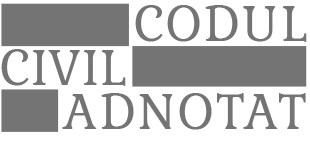Article 11. Common Parts
(1) The following constitute common parts:
a) the plot of land, within the established boundaries, on which the building and its annexes are located, composed of both the built-up area and the unbuilt area, which, according to the nature or purpose of the building, ensures access, proper exploitation of the building, and service to the owners. The delimitation of the boundaries of this land is carried out in accordance with legislation and urban planning documentation, respecting regulations concerning the minimum space required for residential areas (rest areas, playgrounds, parking spaces, etc.);
b) the building itself with all annexes, common equipment elements, including the infrastructure parts related to it that cross the units and common parts;
c) the foundation, passageways, stairs and staircases, corridors, perimeter and partition walls between properties and/or common spaces and the basement, intended for common use, chimneys, halls, networks for drinking water and domestic hot water supply and sewage networks, electrical networks, electronic communications, thermal energy and gas supply from the connection to the distribution point to the units in exclusive property, rainwater channels, lightning rods, collective antennas, the attic and cellars, intended for common use, storage boxes, laundry rooms, drying rooms, elevators, intercoms (the part of the installation on common property), water tanks, the building’s own heating system, waste evacuation ducts, structural framework, façades, roof, terraces;
d) other spaces in the building that are not exclusively owned by the owners and that are designed to meet the social and living needs of the owners, including space for recreation, cultural development, physical education, and sports, children’s playground;
e) the courtyards, gardens, and access ways located within the boundaries of the condominium land.
(2) The points of delimitation of the internal networks and installations in the condominium and the public networks and installations are:
1) for water supply networks – the exit from the metering equipment (meter) installed in the basement/technical floor of the residential block, according to the connection notice issued by the service operator;
2) for sewage networks – the connecting manhole to the public network in the direction of wastewater flow;
3) for centralized thermal energy supply networks – the last flanges from the third and fourth valve after the elevator node, as follows:
a) in the case of an individual thermal point (PTI) on the supplier’s balance – the exterior wall of the PTI building at the exit of the thermal networks;
b) in the case of an individual thermal point (PTI) on the consumer’s balance – the exterior wall of the residential block;
c) in the case of residential blocks with elevator nodes – the last flanges at the third and fourth valves;
d) in the case of residential blocks with control nodes – the valves after the accounting node;
e) in the case of residential blocks without a basement – the exterior wall of the residential block.
(3) In the event of destruction or demolition of the building, the land on which the building was located, including the land intended for the operation of the building’s maintenance installations and territorial development, is maintained with common ownership by shares of the owners in accordance with the share at the time of destruction or demolition. The co-owners continue to possess, use, and dispose of this land in accordance with the legislation.
(4) Common parts also become the adjacent lands or constructions adjacent to the condominium acquired by the association based on the resolution of the general meeting, even if the association is indicated as the owner in the immovable property register.
